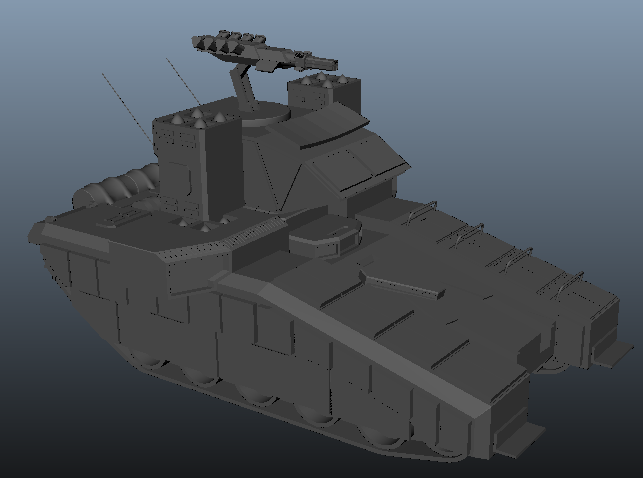Hello everyone, KrimsonStorm here. This week I’ve been pretty frantic. Practically every course I have has had a project and/or test due this week as well as some real life issues, so I wasn’t able to do as much work as I normally would have. However, I still managed to work on a number of various things for the Parallax Project.
The first thing that I’ll show off here is my work in progress mesh for the Squad Automatic Weapon:

As you can see, it’s got the very basic shape down for the model. The way I go about doing my game modeling process is I first go for making a medium poly mesh. When it gets to that point, I’ll then generate a low poly version that you play with, and a high poly version to help the model look even better using normals.
Since this weapon does not fire any true rounds, we have the opportunity to experiment with different ways of making a weapon work. There is no spin to put on a ball of gas, or on a lazer, so the barrel can be any shape we want to design interesting forms. In this universe, plasma weapons don’t have circular barrels. We went with a more square-trapezoidal barrel form. In the following week, I’ll finish this weapon up and talk much more about this weapon as it gets finished up.
I also did concept art for the next thing asset piece I will be working on, that got a lot of positive feedback on, and that was the Vehicle Pad:

The vehicle pad, when idle, is similar to the pads you see on a lot of other videogames. It is mostly a flat platform where the vehicle comes from. The big difference here, is that when it starts to build the vehicle, it really comes to life. On the right side of the picture, there are 3 stages of construction, that illustrates the different ways the machine will behave over the course of a vehicle’s construction. As with the Weapon Dispenser, the Vehicle Pad will have a lot of character in it’s animation.
The last thing, and what took the most amount of time for me this week, was checking out the map that Melissa was working on for her thesis in the past few weeks. (She’s a great environment artist, you can follow her here.) Using my game design and level theory thinking, I put it under the microscope and figured out what worked and what needs changing to make this a successful game.

I loaded up the map, and took an Arial view of the layout. I located the bases on the map and put big gray markers on where they were. The Purple and Green bends are the respective team bases, which will have a dam-like appearance to them.

After I got the locations of the bases set up, I wanted to see how the map would function. I went through and did time trials to judge distance.The time, T, was an average of 4 trials I did for each category. Understanding base distances helps figure out the likely paths players will take. For example, from the purple base, it is faster to get to bases 2 and 13 than bases 11 and 7. Purple team players will start off going to bases 2 and 13 before migrating to the other bases. Also, the position of bases 3 and 13, being in a thin canyon strip in the bigger open canyon, so the paths they can take will be slimmed down. From base 13, the best option to go for would be to base 5, or back to base 2 or the home base.
There are some more items in there, such as the TTK and TTKr. TTK, or Time To Kill, is the approximate time a weapon will take to kill a player 1 on 1 if they have perfect accuracy. Then you have TTKr, which is a real form of TTK. Players are never perfectly accurate, and after doing a lot of digging and looking through existing game stats, it seems that the average accuracy of a player is 30%, so I took the TTK and adjusted it accordingly. Another thing I looked at was the time it takes to transfer control from one side to the other. We decided to double the time from 20 seconds, seen in the graph, to 40 seconds after going over the data.
The main reason we wanted change this is this diagram:

Currently, using standing walking speed of humans, the distance one can travel in 6 seconds is represented in the red circle. Since we decided that the map should be increased by 30%, as well as increase the average players walking speed, travel times will stay mostly the same. This just means that the map will be more open and will allow players to round corners and dodge shots a little better. The increase in speed, roughly 30 percent, is shown in the yellow ring. Under regular walking speed, that distance would take 8 seconds, and in a shooter game when milliseconds count, that is a huge game-play difference.

After doing that, I did some tweaking of the base locations and numbers, as well as pathing. All the red dots are changes in the location of the base. The yellow dots are additional bases, so we can have some overlap. The brown paint strips are changes in the thin canyon gorges. Black lines indicate roads, or other major avenues of travel.
I also took a look at the relative height of the map. While the extreme heights of the map are good, inside of the canyon, where players can interact, is very very steep. Some of the canyon pieces are placeholders, so there isn’t much the game design portion of me can critique that. I still think we can get away with nice variations in the height of the terrain while toning it down a little bit.
This week, I have:
Work on level design (6 hours)
Model the SAW (5 hours)
Design the Vehicle Bay (180 minutes)
Had group Meetings (180 minutes)
Wrote this post (120 minutes)

Like I said, next week, I plan on having a completed SAW model to show you guys. I’ll also be putting together a design doc for the project to help keep continuity of the project. Until next time, KrimsonStorm signing off!


























